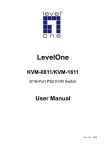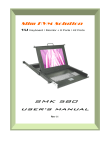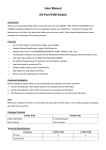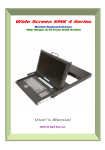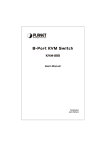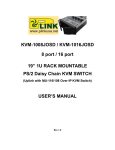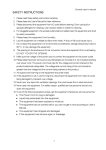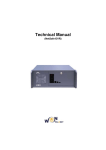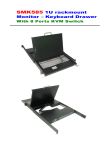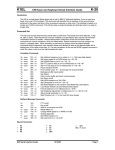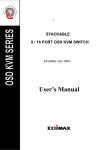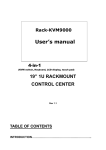Download Introduction - MCM Electronics
Transcript
KS-104OSD / KS-108 / KS-116 USER’S MANUAL TABLE OF CONTENTS INTRODUCTION……………….………………………………………..1 FEATURES…………...………………………………………………….1 PACKAGE CONTENTS……………...…………………………………1 TECHNICAL SPECIFICATIONS………...…………………………….2 SYSTEM REQUIREMENT……………………………………………..3 CABLE DIAGRAMS…………………………………………………….4 PRODUCT DETAILS……………………………………………………4 HARDWARE INSTALLATION…………………………………………5 USAGE……………………………………………………………………5 ON SCREEN DISPLAY OPERATION…………………………………8 TROUBLESHOOTING………………………..……………………….10 CERTIFICATES………………………………………………………..11 2 Introduction Thank you for purchasing TOP-VIEW KVM switch. TOP-VIEW KVM switch can save your MONEY, TIME, SPACE, EQUIPMENT and POWER. Controlling multiple PCs from One Keyboard, Mouse and VGA Monitor. TOP-VIEW KVM switch is loaded with features such as 19” Rack Mount Size, Daisy Chain up to eight units, On Screen Display Manual, Password security, searching PC server name, Hot key Control, Front Panel Push Button and Auto Scan Control. It has complete keyboard and mouse emulation for simultaneous PCs boot-up process. Features z 4/8/16 port KVM switch is 19” rack mount size design. z Support Microsoft Intellimouse, Microsoft Intellimouse Explorer, Logitech Net Mouse or the other fully compatible MS mouse. z Provide Console PS/2 to PC serial mouse conversion z Support DOS, Win3.X, Win95/98/98SE/2000/ME, WinNT, Netware, Unix, Linux z Hot Plug - Add PCs or Remove Connected PCs for Maintenance without Powering Down the KVM switch or PCs. z Very High Video Quality - Up To 1920X1440, Bandwidth: 200MHz z No Software Required - easy PC selection via On Screen Display Manual, Push Buttons, Hot Keys z Support eight characters password protection and search PC server name z Auto Scan Mode for monitoring PCs and flexible Scan time from 5~99 seconds z Keyboard status restored when switching PCs z LED Display for easy status monitoring z Buzzer sound for switching port confirmation. z Using Standard Keyboard, VGA, Mouse cable. z Built-in one extra daisy chain port and no waste any PC port z No DIP switch setting needed and auto detect daisy chain bank Package Contents Model No.: KS 104 4 port KVM Switch 1 PCS User’s manual 1 PCS AC to DC Power Adapter 1 PCS Rack Mount Kit 1 SET Daisy Chain Cable 1 SET 3 Model No.: KS 108 8 port KVM Switch 1 PCS User’s manual 1 PCS AC to DC Power Adapter 1 PCS Rack Mount Kit 1 SET Daisy Chain Cable 1 SET Model No.: KS 116 16 port KVM Switch 1 PCS User’s manual 1 PCS AC to DC Power Adapter 1 PCS Rack Mount Kit 1 SET Daisy Chain Cable 1 SET Technical Specifications Model No. KS 104OSD KS 108 KS 116 PC Port 4 8 16 Console Port 1 1 1 PC Port Connector PS/2 Keyboard mini Din 6 pin (All Female Type) PS/2 Mouse Mini Din 6 pin VGA HDDB 15pin Console Port Connector PS/2 Keyboard mini Din 6 pin (All Female Type) PS/2 Mouse Mini Din 6 pin VGA HDDB 15pin Daisy Chain Port Connector PS/2 Keyboard mini Din 6 pin (All Female Type) PS/2 Mouse Mini Din 6 pin VGA HDDB 15pin PC selection On Screen Display Manual, Hot Key, Push Button 7 segment LED One Bank LED, Two PC Port LEDs On Screen Display Control Yes Scan Intervals 5~99 Sec. Keyboard Emulation PS2 Mouse Emulation PS2 4 Mouse Conversion Console PS/2 to each PC port serial mouse (Only Console port to PC port) VGA Resolution 1920X1440 Bandwidth 200MHz Daisy Chain MAX Level 8 levels MAX PC Connection 116 Housing Metal Power Adapter DC 12V 1A or DC 9V 1A Operation Temperature 0~40℃ Storage Temperature -20 ~ 60℃ Humidity 0~80%, Non-Condensing Size 19” Rack Mount / 1RU 19” Rack Mount / 1RU 19” Rack Mount/ 2RU Weight (kg) 1.5kg 2.2kg 3.5kg Dimension (cm) 41(L) X 16.5(W) X 4.7(H) 41(L) X 16.5(W) X 4.7(H) 41(L) X 22.5(W) X 8.4(H) 120 128 System Requirements Specifications: Model No. Console side Computer side KS 104OSD KS 108 KS 116 One VGA Monitor One VGA Monitor One VGA Monitor One PS/2 Keyboard One PS/2 Keyboard One PS/2 Keyboard One PS/2 Mouse One PS/2 Mouse One PS/2 Mouse 4 HDB 15 pin male to male 8 HDB 15 pin male to male 16 HDB 15 pin male to male VGA cables VGA cables VGA cables 4 PS/2 cable male to male for 8 PS/2 cable male to male for 16 PS/2 cables male to male Keyboard Keyboard for Keyboard 4 PS/2 cables male to male 8 PS/2 cables male to male for 16 PS/2 cables male to male for Mouse Mouse for Mouse 5 Cable Diagrams PS/2 Cable: Mini Din 6 pin Male to Male , VGA Cable: HDB15 pin Male to Male AT to PS/2 keyboard adapter: Din 5 pin Female to Mini Din 6 pin Male Product Details Front Panel & Rear Panel of KS 104OSD: Top View DC 12V Made in Taiwan Daisy- chain in C onsole p or t Monitor M on itor Keyboar d Mouse Keybo ar d KVM Sw itch 4 Por ts W ith O.S.D Comp ute r 8 Pow er On Co mputer 7 Compute r 6 Co mputer 5 Mou se Front Panel & Rear Panel of KS 108: Top View DC 12V Made in Taiwan Daisy- chain in C onsole p or t Monitor M on itor Keyboar d Mouse Keybo ar d KVM Sw itch 8 Por ts W ith O.S.D Comp ute r 8 Pow er On Co mputer 7 Compute r 6 Co mputer 5 Compute r 4 Co mputer 3 Compute r 2 Co mp uter 1 Mou se 6 Front Panel & Rear Panel of KS 116: Top View KVM Sw itch 16 Por ts W ith O.S.D Pow er On Daisy-ch ai n in Mon itor DC 12V Made in Taiwan Keyboard Mouse Computer 16 Comp ute r 15 Comp ute r 14 Computer 13 Computer 12 Computer 11 Computer 10 Co mputer 9 Comp ute r 8 Co mputer 7 Co mputer 6 Compute r 5 Comp ute r 4 Comp ute r 3 Comp ute r 2 Co mputer 1 C onsole p or t Monitor Keyboard Mouse Hardware Installation Before installation, please make sure all of peripherals and computers have been turned off. 1. Connect the Keyboard, VGA, Mouse cables to the computer ports of KVM switch 2. Connect the Keyboard, VGA monitor, and Mouse to the console port of KVM switch 3. After Powering on computers and finishing the boot-up process, you can start to go KVM switch. Note: Please don’t switch the PC port (i.e. Don’t press the push button of KVM switch or run hot key) during the computers are under boot-up process. Usage The power on state of 4/8/16 port KVM switch: When you power on KVM switch, it will ask you the password, the default password value is eight zero –“ 00000000 “. Please key in eight zero and enter the same value at retype field. Note: Before you are not familiar with the operation of OSD manual, please don’t change the password – i.e. keep default eight zero (00000000) value. Otherwise, if you have set the password and unfortunately forget the password, you need send it back to your distributor for maintaining the password. The Push Buttons: Pressing the button cyclically through all the ports. KS 104OSD (4 Port) 1 2 3 4 7 LED Indication: You can press the button in order like mentioned-above diagram. When you select one of four PC ports and this PC is shut down or this PC port is disconnected to the PC, the selected port LED will flash. When you select one of four PCs ports and this PC is powered on, the selected port LED is lit. KS 108 (8 Port) 1 2 3 4 5 6 7 8 LED Indication: You can press the button in order like mentioned-above diagram. When you select one of eight PC ports and this PC is shut down or this PC port is disconnected to the PC, the selected port LED will flash. When you select one of eight PCs ports and this PC is powered on, the selected port LED is lit. KS 116(16 Port) 1 2 16 15 3 4 5 6 7 8 14 13 12 11 10 9 LED Indication: You can press the button in order like mentioned-above diagram. When you select one of sixteen PCs ports and this PC is powered on, the selected port LED is lit. When you select one of sixteen PC ports and this PC is shut down or disconnected a PC, the selected port LED will flash. Keyboard Hot Key Commands: You can also conveniently command Top-View KVM switch by switching ports through simple key sequences. To send commands to Top-View KVM switch, the “SCROLL LOCK” key must be pressed twice within 2 seconds. You will hear a beep for confirmation and the keyboard is in hot key mode. If you have not pressed any key in hot key mode within 2 seconds (It means to key in any key follows up “Scroll Lock” “Scroll Lock” key ), the keyboard will back to under Operation System control state. Below are the different hot key commands: within 2 seconds Scroll Lock + Scroll Lock + = Previous Channel 8 Scroll + Lock Scroll + = Lock Next Channel (Note: You also could press “up arrow key” or “down arrow key” longer time to speed up selecting the destination port) Scroll + Lock Scroll Scroll + Lock Scroll = Previous Bank Up Lock + Page + Page = Lock Down Scroll Bank No. Next Bank To select PC port: Scroll Lock + Lock Port No. + Port No. 1~4(4 port) 1~8 0 or 1 1~8(8port) 1~6(16port) Scroll + Lock Scroll Scroll + Lock + Lock Scroll B = Beeper (Note: The default Beeper function is ON) + Lock S = Auto Scan To get out of Auto Scan Mode, Press any key or SPACE bar. Scroll + Lock Scroll + Lock R = OSD default value (Note: Not including password) ROM Scroll Lock + Scroll Lock + F = REFLASH Search the same PC name (Note: Search PC name starting from 1st PC port) FIND:█ 9 Scroll + Lock Scroll + Space bar = On Screen Display Manual Lock On Screen Display Operation When you pop up the OSD manual window go through the hot key, you will see the following small window on your monitor. BANK : 1 01 a. The 1ST line bar is Bank no. SYSTEM 01 02 ☼SYSTEM 02 ( 03 ☼SYSTEM 03 04 ☼SYSTEM 04 05 ☼SYSTEM 05 06 SYSTEM 06 07 SYSTEM 07 08 ☼SYSTEM 08 09 SYSTEM 09 10 SYSTEM 10 11 ☼SYSTEM 11 12 ☼SYSTEM 12 13 SYSTEM 13 14 ☼SYSTEM 14 15 ☼SYSTEM 15 16 16 OSD : 1 0 SEC. SYSTEM CHANGE PASSWORD SCAN: 1 0 SEC. CONSOLE ON/OFF ESC : QUIT ENTER :COMPLETE TAB : NEXT INSERT :EDIT ©/ª: SELECT b. The 2nd block is your PC system name list. You will find the system number list from 01 to 04 ( if the current box is 4 port) or from 01 to 8 (if the current box no. is 8 port)or from 01 to 16 (if the current box no. is 16 port). You can define your PC name in maximum 8 characters. The factory default of 16 port KVM switch PC name is from “SYSTEM 01”, “SYSTEM 02” ,…, “SYSTEM 16” and 8 port KVM switch is from “SYSTEM 01”, “SYSTEM 02”,…, “SYSTEM 08”. Besides, the sun symbol “ ☼ “ near to the PC name represents the PC system is powered on. PORT PgDn/PgUp: BANK SELECT To use up arrow key “ y “ or down arrow key “ z “ to select port for destination PC name. After you have selected the PC port already, you can press the ENTER Key to switch the PC port you want immediately To use “ PgUp “ key or “ PgDn” key for selecting previous or next Bank no. (or Box No.) BANK : 1 01 SYSTEM To press “ INS” key for editing PC 01 02 ☼SYS█EM 02 ( name. 10 After finishing the edit, please press “ Enter “ key for saving information. To use “ Tab “ key to select items like Bank, OSD, SCAN, CHANGE PASSWORD, CONSOLE ON/OFF, etc… 15 ☼SYSTEM 15 16 SYSTEM a. The “ OSD: 10 SEC” means that 16 the OSD windows display or PC OSD : 1 0 SEC. ( CHANGE PASSWORD SCAN: 1 0 SEC. CONSOLE system name exists 10 sec. on your monitor. You can modify it ON/OFF from 05 sec to 99 sec. The ESC : QUIT ENTER :COMPLETE TAB : NEXT INSERT :EDIT factory default value is 10 sec.. b. The “ SCAN TIME” means that scan interval from one PC port to next PC port. The default SCAN time is 10 sec and the maximum scan time is 99 sec. c. The “ CHANGE PASSWORD” is for user to avoid all PC systems to be intruded by the other person. The default password is 8 digits “ 00000000 “. ENTER ESC : QUIT PASSWORD : █ ENTER : COMPLETE There is an enter password window showed out when you select this item and then press the Enter. The maximum password is eight digits. After you key in the password already and press the Enter key, there is another window for confirming your typed password. ENTER NEW ESC : QUIT RETYPE NEW ESC : QUIT PASSWORD : █ ENTER : COMPLETE PASSWORD : █ ENTER : COMPLETE You need to retype the password again for rechecking your previous key-in password is matched or not. NEW PASSWORD ESC : QUIT COMPLETE ENTER : COMPLETE d. The “ CONSOLE ON/OFF “ means to manage the console of KVM switch. If you select “ CONSOLE ON “, it means that any user can use the console. If you select “ CONSOLE OFF “(factory default OFF state), it means that any user will not be allowed to use the console unless you enter the password. When you enter the password already and pass the KVM switch authentication, the CONSOLE will be set to ON. After you finish using KVM switch, please don’t forget to set up CONSOLE ON state to OFF 11 state. Besides, if current CONSOLE is ON state and you reset KVM switch, the CONSOLE will be set up ON state back to OFF state. e. When you finish the set up of PC name and get out of OSD setting mode, you will find the PC name showed at the up-left corner of monitor. Now, you can use ESC key to clear the message right away if you don’t need it. f. 102 ☼SYSTEM 02 If you want OSD returning back to factory default value, you can execute “SCROLL LOCK”, “SCROLL LOCK” , “R” keys in order. The Seven segment LEDs on the front panel will be flashed during the refresh process. ROM REFLASH When the OSD value back to default setting, the seven segment LEDs on the front panel will stop flashing Troubleshooting Ensure that all cables are well seated. Label all of cables with the number for each respective computer to avoid confusion. 1. The Power Jack polarity is center positive and the power adapter need be DC12V, 1A or DC9V, 1A. 2. Don’t press any keys on the keyboard while the selected computer is booting up. Otherwise, it might cause the keyboard error or keyboard is not detected at PC side. 3. The computer boot up fine, but keyboard doesn’t work z Make sure the keyboard works when directly plugged into the computer. z Try a different keyboard, but use only 101, 102 or 104-key keyboard. 4. The Mouse is not detected during PC boot up. z Make sure the mouse works when directly plugged into the computer. z Make sure the mouse is a true PS/2 mouse. A combo mouse will work just as long as it is set for PS/2 mode with the correct adapter. Try a different mouse. z Avoiding moving the mouse or pressing the mouse buttons when switching ports. z Avoiding switching ports during shutting down the PC process. z When you switch one PC port to another PC port, the best scan time setting need to be set to 5 sec. or more. Normally, the VGA monitor change one resolution mode to another will take one or two seconds. So, the scan time is not recommended to below 5 seconds. 12 CERTIFICATIONS FCC This equipment has been tested and found to comply with Part 15 of the FCC Rules. Operation is subject to the following two conditions: (1) This device may not cause harmful interference, and (2) This device must accept any interference received. Including interference that may cause undesired operation. CE – Certificate This equipment is in compliance with the requirements of the following regulations: EN 55 022: CLASS B 13














